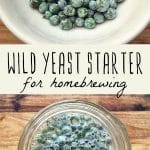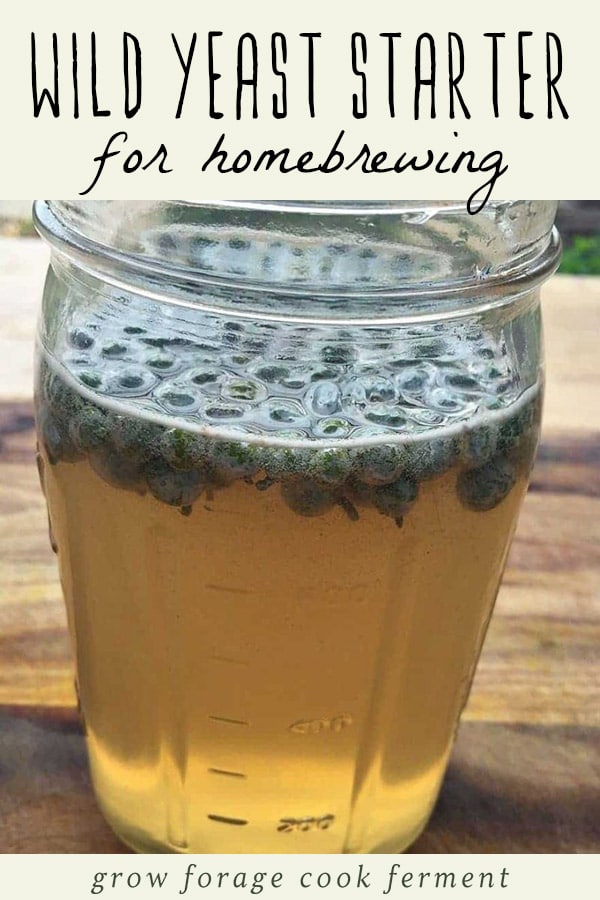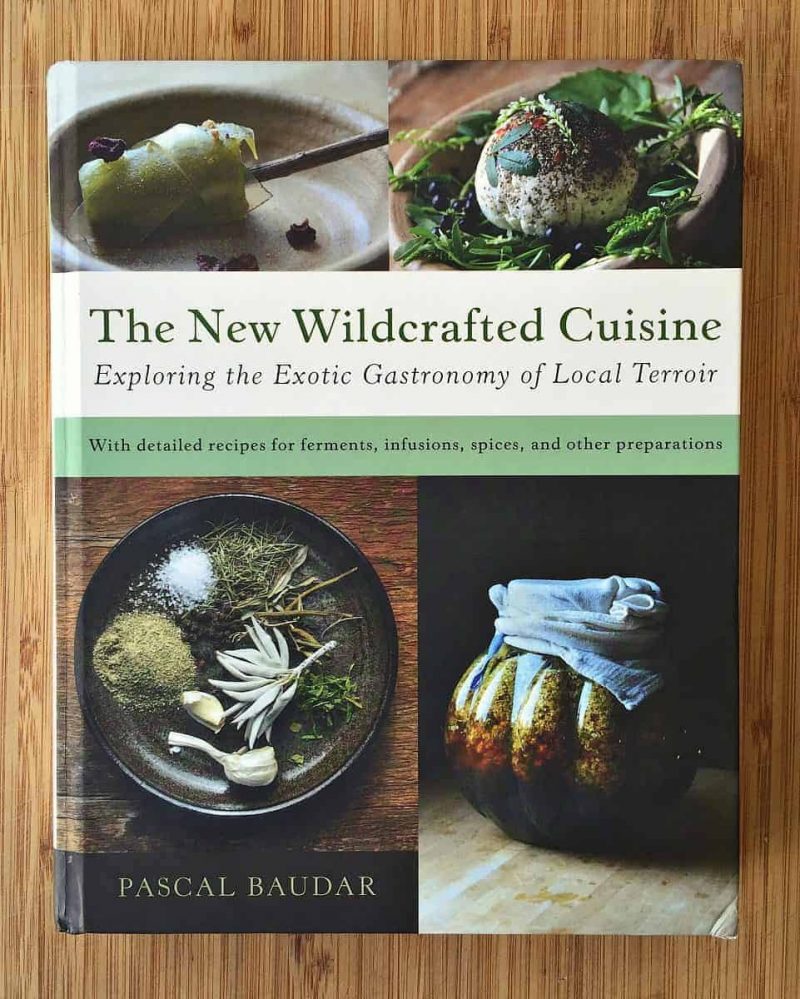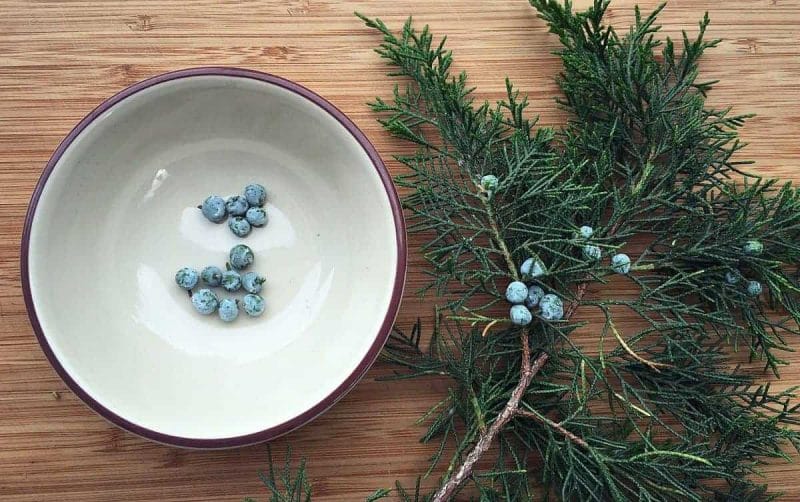Learn how to make a wild yeast starter for home brewing and natural sodas. This wild yeast starter is made using foraged juniper berries, and is very easy to make!
Cultivating Wild Yeast for Brewing
With all the mead and hard cider brewing that I’ve done, up until now I’ve never tried cultivating my own yeast.
With the effort that’s involved and the cost of high quality honey, I never wanted to risk tainting my brew with who knows what kind of random yeast that might be floating by.
It can create off flavors, some so bad that you end up with something totally undrinkable (the horrors!).
But, it can also produce wonderful and complex tasting brews, and for this reason I always knew that I would try it someday.
Besides, this is how people have done it for centuries, before commercial brewing yeast was ever available.
I’m always one to do things from scratch the hard way, not for punishment, but because I thoroughly enjoy the process (and because it makes things taste how they’re supposed to).
So, when I received a copy of Pascal Baudar’s new book, The New Wildcrafted Cuisine, and saw a recipe for cultivating your own wild yeast, I knew I had to try it!
The New Wildcrafted Cuisine
I’m going to start off by saying that if you haven’t checked out Pascal’s book, The New Wildcrafted Cuisine, I suggest that you do!
It is a tome of great information on foraging and all of the wonderful things that you can make with your foraged ingredients.
The recipes in this book sound intriguing, such as Acorn Pancakes, Pickled Unripe Black Walnuts, Nasturtium and Watercress Hot Sauce, and Primitive Gourmet Crackers.
He also has multiple recipes for wild homebrews and sodas, one of which I’m planning on making using this wild yeast starter – Mugwort Lemon Beer.
How to Make a Wild Yeast Starter with Juniper Berries
The first step in making a wild yeast starter is to gather some berries or fruit that have a natural coating of wild yeast.
Pascal recommends using juniper berries, elderberries, wild grapes, blueberries, or figs, among others. I would guess that Oregon grape berries would work as well.
I chose to use juniper berries, mainly because I knew where some were located and because our elderberries aren’t in season yet.
These had a gorgeous white bloom on them, indicating wild yeast.
After you’ve collected your wild fruit, make a sugar solution with a ratio of approximately ¼ sugar to ¾ water, and put into a super clean jar with the berries or fruit. I made mine in a quart sized jar.
This looks very similar to the smreka (fermented juniper berry soda) I attempted back when I talked about foraging for juniper berries. That did not turn out well, as it developed an off flavor pretty quickly.
For this starter, I decided to use an airlock system (like The Easy Fermenter or Masontops Complete Fermentation Kit), in hopes of keeping it a little more pure. You could just cover it with a cloth and rubber band, though.
Put it in a warm and dark place, and stir or shake it three to four times a day. Within four to five days, you should start seeing some bubbles! Make sure you smell it as well, and if it has a bad odor, then don’t use it.
In the book Pascal says that the large quantity of yeast on the types of fruits listed above almost always insures a successful fermentation, and that his method is almost 100 percent effective.
Mine got really bubbly around day five, and is now ready to be used in a wild homebrew. I used this starter in a Mugwort and Lemon Beer recipe and it turned out great!
Besides alcoholic brews, this starter can also be used to make homemade natural sodas, or even as a way to get a sourdough starter going.
Generally less sugar is used when using a wild yeast starter versus commercial yeast for homebrewing, as wild yeast can’t survive in higher alcohol concentrations.
This means that it will be a lower alcohol brew, which sounds great for a hot summer day!
I’m really excited to use my wild yeast starter! Have you ever brewed with wild yeast?
Here are a few more naturally fermented drink recipes:
- Fermented Elderberry Soda
- How to Make a Ginger Bug
- Fermented Apple Ginger Beer
- Strawberry Rhubarb Soda
- Hard Cider with Wild Yeast
Wild Yeast Starter for Homebrewing
Equipment
Ingredients
- ½ cup sugar
- 1 ½ cup water
- ½ cup berries or fruit with natural yeast such as juniper berries, elderberries, blueberries, grapes, or figs
Instructions
- After you’ve collected your wild fruit, make a sugar solution with a ratio of approximately 1/4 sugar to 3/4 water, and put into a super clean jar with the berries or fruit. I made mine in a quart sized jar.
- For this starter, I decided to use an airlock system to keep it a little more pure. (You could just cover it with a cloth and rubber band, though).
- Put it in a warm and dark place, and stir or shake it three to four times a day.
- Within four to five days, you should start seeing some bubbles! Make sure you smell it as well, and if it has a bad odor, then don’t use it.
Notes
- Besides alcoholic brews, this starter can also be used to make homemade natural sodas, or even as a way to get a sourdough starter going.
- Use 1 cup of wild yeast per gallon of water in a beer recipe.
Nutrition











This was really helpful. Since reading this I’ve gotten starters from grapes, juniper, and autumn olives.
Thank youuuuuu! Josh
You’re welcome!
Yes!! This worked very well. I used autumn olives for my first batch. They’re bubbling along right now. It’s alllll good.
Jack
Can I make country wine with this starter? At the same proportion of 1 cup per gallon?
thanks for sharing!!
Hi Stephanie, I think this would work well for making country wine! I would start with 1 cup per gallon.
Hi, do the measurements for making bread equally translate for this liquid? In other words if I use a teaspoon of yeast in my bread recipe what I use a teaspoon of this liquid?
Hi there. I’ve never used a wild yeast starter in place of commercial yeast, so I’m not sure how much you should use. It would be a good experiment to try though!
Can I freeze this starter to have on hand?
No. Freezing kills the wild yeast that’s needed for fermentation. However, refrigerating it will cause it to go dormant. When ready to use, resume feeding.
How about dehydrating?
No. The heat will destroy the wild yeast. Freezing it is the only way to keep the bacteria alive and intact.
I will definitely try using some of the Autumn Olives that I harvested to make a yeast. I picked over 50 pounds of them after reading your post. I dehydrated and powdered them and add the results to a variety of things for an antioxidant boost.
Awesome! Good luck!
I made this with some Juniperus virginiana berries and it is smelling wonderful and bubbly. It’s very sweet and bread-like. One weird thing though- it has a gel-like consistency. What happened there? Is it just my particular strain of yeast on the berries? I am in Michigan. I plan to use it in a mead and it smells fine with no mold on it so I’m assuming all is well…
I’ve never seen that happen, but I assume it’s totally fine. If it smells fine and there’s no mold, it’s typically safe to use.
Can I use dried Juniper berries that I buy at the store? Or do they have to be fresh?
You would need to use fresh for them to ferment since they’ll still have their wild yeast bloom.
Hey! First of all, I’ve loved your website a long time and I plan on buying your book. I’m going camping this weekend and I plan on gathering yeast with my cool little bootleg biology kit. I‘m having a hard time finding out if you can use the yeast from white spruce tips for fermenting and making starters as well—could you point me in the right direction?
I am so happy to have come upon your recipe with juniper berries! I live near the Oregon border and have the most beautiful very full of berries Juniper that I want to forage some and make this recipe.
thank you!
Liz
Hi there- I made this 2 days ago and I just went to stir it and it’s molding! Any ideas on what I can do to prevent that?!
Always make sure to use filtered water (or water without chlorine) when making a homemade wild yeast starter (or when fermenting veggies traditionally), because otherwise the chlorine will kill the wild yeast and it will likely not work. In a pinch, you could use tap water that has been sitting out for over 24 hours to allow the chlorine to dissipate, but it’s probably best to use filtered water to take out the impurities before attempting to make a wild yeast starter.
I did something like this with honey and organic blackberries and blueberries for a wild starter for a mead. Got surprisingly more abv than I thought it would
I make wine every fall, but do you think I could kid make this starter and freeze the liquid when it is active then throw the frozen cubes of yeast starter into my grape juice and when it melts and comes up to temp it would activate the whole batch?
Had great success with wild raspberries last year, accidentally. Had harvasted them and cleaned the stems and leaves off and was all set to take a stab at jam…and got distracted (story of my life). Came across the container while digging for mushrooms for a stew, and lo and behold, I had hooch. I had quit drinking the year before (of course) so, not wanting to waste, began a sourdough starter which worked exceptionally well for an accident…
So.. I don’t know if it qualifies as an off aroma, but it smells similar to my milk kefir. Somewhat like a cheese type fermentation aroma. I made it with great success before, but with different berries from a different location. Think this could be a possible factor in the difference of aroma?
Wild yeasts are always unpredictable!
Is it only really plausible to try and make your own wild yeast starter during the spring when pollen is more rampant and yeast is more rampant on the berries? Or is there a particular time you’ve noticed its best? This is so cool that you made your own yeast starter. Can you use this with any form of cooking that uses yeast? Or do you usually just use it for brews? Thanks for sharing!
Any time of year is fine, and actually some of the best berries/fruits aren’t ready until fall. I’ve only used it for brews, but I supposed it could maybe be used in other ways. Time to experiment!
Hello could you please answer Claira and Mary V’s questions. I feel they are important as I also have the same questions.
Awesome website!! I haven’t made beer or mead yet but I have brewed the most amazing magical wild wine. Looking forward to trying this and the mugwort lemon beer, I also am hoping to make a nettle beer.
Thank You!
Happy Brewing!!
Hi Elizabeth, I answered those questions above. Sorry for the delay! Thank you, and I’m glad you like my site :)
Very good!It can be used to make bread?
Maybe… I’ve never tried it, but it’s definitely possible! I would use the liquid to make a sourdough starter first and see what happens.
Wild currents are always covered with that bloom too….
How ratio of fruit do you need for the 1/4 cup sugar and the 3/4 cup water brew? Also, how do you keep it going? Thanks. This is great and I can’t wait to try it.
So the recipe from the book is just a basic ratio: 3/4 water to 1/4 sugar. That means you can make whatever size you like of starter, and he isn’t specific about the amount of berries. I made mine in a quart jar and used probably about 1/2 cup of juniper berries.
ohh i am going to make one of these straight away, but how long does it keep? i.e. should i use it within a particular time frame? or can i keep it for a period in the fridge? ohh and would it work as a continuous fermentation? i.e. like a ginger bug by continuing to add fruit and sugar? ohh and one more question what do you do with the fruit once it is ready? I intend to use blueberries and really don’t like wastage – can they be used in something like a soda as well?
Sorry for all the questions, i am going though a bit of a fermenting craze and still trying to get my head around all the different methods.
Thank you for this wonderful post
Sorry for the very late reply, not sure how this slipped past me… yes, you could probably keep it in the fridge for a while and it would be just fine. it would probably also work as a continuous fermentation if you continued to feed it. Since juniper berries aren’t usually eaten, I just composted them, but if you use blueberries you could definitely try to make something with them. Not quite sure how it would taste, but it’s worth a try!
Can I use honey instead of sugar? we tend not to buy granulated sugar.
You could. That might be better since the complex sugars trigger the yeast for a broader fermentation.
Can I use bananas instead of berries.
I live in India, in the city of Chennai, and we can never gather berries as the are no hills or berry plants to be found.
I think you might be able to brew with bananas, but with some caveats. (Don’t read on unless your curiosity is stronger than your stomach!)
I remembered reading as a school child how some Amazonian Indians (the Yanamamo tribe, in particular) made beer with bananas in dugout logs. I would imagine the yeasts they needed were on the peels. However, the starches in bananas and plantains are very complex compared to sucrose (table sugar).
I looked into it as an adult and found these natives would purposely spit into the ‘wort’ as part of the process. Saliva contains enzymes that begin to break down carbohydrates as part of our digestive process, which might help the natural yeasts bloom easier.
I’d suggest adding table sugar to banana peels instead, or if you have access to freshly plucked curry leaves or other outdoor spices try some of those. You may be pleasantly surprised with the results.
Refining a wild yeast can help get the bad organisms out. Once it’s going, it may ‘eat’ one part a banana mash of equal parts mash and water plus one part of your successful first start. Throw the rest of your first starter away.
The next time it doubles in size, throw half away and add half again as much equal parts mash and water by weight.
If this works, you’ll have enough starter culture to use, some to store, and some to share.
I am going to try this with juniper berries as well to get a sourdough starter going for my potato Rosemary rolls! I think any flavor the juniper imparts would be awesome. Thank you for sharing this – now I am off to check out that cookbook!
You’re welcome! It’s a great book :)